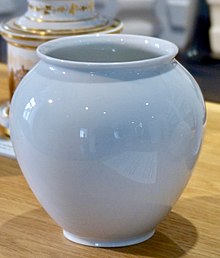Canning harbor
A Einmachhafen is a vessel made of porcelain , which in World War II as a substitute for mason jars produced.
Historical context
During the Second World War, porcelain production in Germany was switched to products that were important to the war effort , such as technical porcelains, dipping molds for rubber gloves and gas masks, as well as the utensils prescribed in a war program that were limited to the most essential parts. Porcelain manufacturers that could not adapt to war-necessary products and that only made tableware, coffee tableware and decorative objects were threatened with closure due to the rationing of raw materials. The non-regulated service parts only included plates, cups, bowls, bowls, milk cans, mugs and jugs.
Preservation ports of the Fürstenberg porcelain factory
From 1940, the director of the Fürstenberg porcelain manufactory Fritz Kreikemeier had three and four-part sets of canning ports made from white porcelain, which were among the most successful products of the manufactory during the war years. Walter Nitzsche developed the Form 651 and Form 652 series . Large vase models by Wilhelm Wagenfeld ( Form 987 ) and Siegfried Möller ( Form 1047 ) were rededicated as Einmachhafen and given the bottom mark "Einmach-Hafen and the year". Some models could also be used as salad bowls, so-called kumps . With this re-declaration, the company managed to maintain porcelain production in times of war. Jam and fruit could be stored in the canning ports and covered with cellophane foil .
literature
- Christian Lechelt : The Fürstenberg Porcelain Manufactory - From privatization in 1859 to the present. In: The Braunschweigische Stiftung - Richard Borek Stiftung - Stiftung Braunschweigischer Kulturbesitz (ed.): Die Porzellanmanufaktur Fürstenberg , Volume III, Appelhans, Braunschweig 2016, ISBN 978-3-944939-23-0 , Die Form 639 by Wilhelm Wagenfeld, p. 159-160
